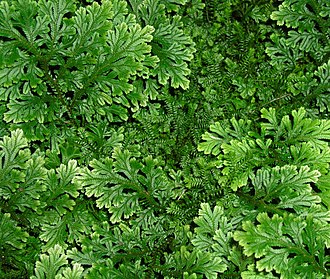Selaginella

Selaginella is the sole genus of vascular plants in the family Selaginellaceae, the spikemosses or lesser clubmosses.
This family is distinguished from Lycopodiaceae (the clubmosses) by having scale-leaves bearing a ligule and by having spores of two types. They are sometimes included in an informal paraphyletic group called the “fern allies”. S. moellendorffii is an important model organism. Its genome has been sequenced by the United States Department of Energy’s Joint Genome Institute.[1] The name Selaginella was erected by Palisot de Beauvois solely for the species Selaginella selaginoides, which turns out (with the closely related Selaginella deflexa) to be a clade that is sister to all other Selaginellas, so any definitive subdivision of the species into separate genera leaves two taxa in Selaginella, with the hundreds of other species in new or resurrected genera.
Selaginella occurs mostly in the tropical regions of the world, with a handful of species to be found in the arctic-alpine zones of both hemispheres.[2]
Selaginella species are creeping or ascendant plants with simple, scale-like leaves (microphylls) on branching stems from which roots also arise. The stems are aerial, horizontally creeping on the substratum (as in Selaginella kraussiana), sub erect (Selaginella trachyphylla) or erect (as in Selaginella erythropus). The vascular steles are polystelic protosteles. Stem section shows the presence of more than two protosteles. Each stele is made up of diarch (centre of origin on the inside, later cells are added centrifugally) and exarch (centre of origin located laterally, later cells are added centripedally) xylem in centre.[clarification needed][citation needed] The steles are connected with the cortex by means of many tube-like structures called trabeculae, which are modified endodermal cells with casparian strips on their lateral walls.[citation needed] The stems contain no pith.[citation needed]
Unusually for the lycopods, which generally have microphylls with a single unbranched vein, the microphylls of Selaginella species contain a branched vascular trace. In Selaginella, each microphyll and sporophyll has a small scale-like outgrowth called a ligule at the base of the upper surface.[3]:7 The plants are heterosporous with spores of two different size classes, known as megaspores and microspores.[citation needed]
Under dry conditions, some species of Selaginella can survive dehydration. In this state, they may roll up into brown balls and be uprooted, but can rehydrate under moist conditions, become green again and resume growth. This phenomenon is known as poikilohydry, and poikilohydric plants such as Selaginella bryopteris are sometimes referred to as resurrection plants.[citation needed]
